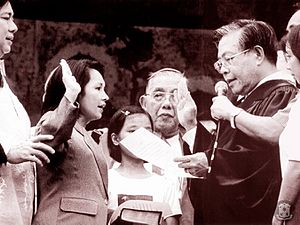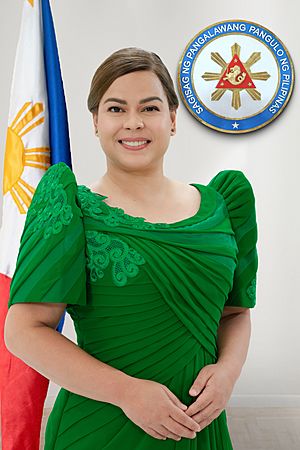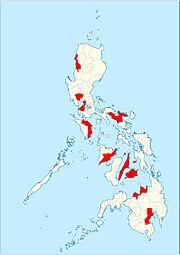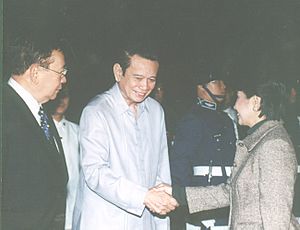Vice President of the Philippines facts for kids
Quick facts for kids Vice President of the Philippines |
|
|---|---|

Vice presidential flag
|
|

Vice presidential seal
|
|
| Government of the Philippines Office of the Vice President |
|
| Style |
|
| Member of | Cabinet |
| Seat | 11th Floor, Robinsons Cybergate Plaza, EDSA cor. Pioneer St., Mandaluyong 1550, Philippines |
| Appointer | Direct popular vote, or, if vacant, President via congressional confirmation |
| Term length | Six years, renewable once consecutively |
| Constituting instrument | 1987 Constitution of the Philippines |
| Formation | November 15, 1935 |
| First holder | Sergio Osmeña |
| Succession | First |
| Salary | ₱353,476 monthly |
The Vice President of the Philippines is the second most important leader in the country's executive branch. This person is next in line to become President if something happens to the current President. Filipinos directly vote for the Vice President, just like they do for the President. These are the only two national leaders elected by the people.
The current Vice President's office was brought back by the 1987 Constitution. This was similar to how the office worked under the 1935 Constitution. A Vice President can serve two terms, each lasting six years. The current Vice President, Sara Duterte, started her term on June 30, 2022.
What is the Vice President's Title?
The official Filipino name for the office is Pangalawang Pangulo. However, many people use Bise Presidente, which comes from Spanish. This name is common in languages like Cebuano and Hiligaynon language. The 1987 Constitution used a hyphen, writing "vice-president." Today, it's usually written as "vice president" without the hyphen.
A Look at the Vice President's History
Early Beginnings
The first person to claim the title of vice president was Mariano Trías. This happened on March 22, 1897, during the Tejeros Convention elections. He was later elected Vice President of the Supreme Council. This council helped with talks for the Pact of Biak-na-Bato in 1897. This council didn't govern a state. It was mainly for bargaining with Spain.
This council was later replaced. When the Philippines declared independence in 1898, there was no vice president. The country's first official republic started in 1899, and it also didn't have a vice president. Because the Supreme Council didn't declare a sovereign state, Trías is not officially considered a Philippine Vice President.
Creating the Role in the Commonwealth
The 1935 Constitution created the position of Vice President. It was similar to the U.S. Constitution. The first person elected to this role was Sergio Osmeña. He was elected alongside Manuel L. Quezon in the first national elections. Unlike in the U.S., the Vice President in the Philippines does not lead the Senate. Senators choose their own leader.
Changes in the Republics
From 1935, the President and Vice President usually came from the same political party. This changed in the 1957 elections. That year, a President and Vice President from different parties won.
The 1973 Constitution removed the office of the Vice President. This meant Fernando Lopez could not finish his term. Later, in 1984, the position was brought back. Arturo Tolentino was declared Vice President-elect in 1986. He took his oath on February 16, 1986. However, many believed the elections were unfair. He never truly served his term. A week later, the People Power Revolution ended the Marcos government.
The People Power Revolution brought Corazon Aquino to the presidency. On February 25, 1986, Aquino and her running mate, Salvador Laurel, became President and Vice President. Since the 1987 Constitution was put in place, only two elections have had a President and Vice President from the same team: Gloria Macapagal Arroyo and Noli de Castro in 2004, and Bongbong Marcos and Sara Duterte in 2022.
What Does the Vice President Do?
The 1987 Constitution says the Vice President takes over if the President dies, becomes unable to serve, or resigns. Beyond this, the Constitution doesn't list many other specific powers. This is why the office is sometimes called a "spare tire." However, the Vice President can be appointed to a Cabinet position without needing special approval.
Serving in the Cabinet
Since 1935, Vice Presidents have often been given roles in the President's Cabinet. Some have even turned down these offers. Sergio Osmeña was the Secretary of Public Instruction from 1935 to 1939. This was a very important role.
| No. | Name | Concurrent appointment | Term began | Term ended | President | Era |
|---|---|---|---|---|---|---|
| 1 | Sergio Osmeña | Secretary of Public Instruction | November 15, 1935 | April 18, 1939 | Manuel L. Quezon | Commonwealth |
| Secretary of Public Instruction, Health, and Public Welfare | December 24, 1941 | August 1, 1944 | ||||
| 2 | Elpidio Quirino | Secretary of Foreign Affairs | July 15, 1946 | April 17, 1948 | Manuel Roxas | Third Republic |
| 3 | Fernando Lopez | Secretary of Agriculture and Natural Resources | December 14, 1950 | 1953 | Elpidio Quirino | |
| 4 | Carlos P. Garcia | Secretary of Foreign Affairs | December 30, 1953 | March 18, 1957 | Ramon Magsaysay | |
| 5 | Diosdado Macapagal | No position offered | Carlos P. Garcia | |||
| 6 | Emmanuel Pelaez | Secretary of Foreign Affairs | December 30, 1961 | July 1963 | Diosdado Macapagal | |
| 7 | Fernando Lopez | Secretary of Agriculture and Natural Resources | December 30, 1965 | 1971 | Ferdinand Marcos | |
| Office abolished | Fourth Republic | |||||
| 8 | Salvador Laurel | Secretary of Foreign Affairs | March 25, 1986 | September 17, 1987 | Corazon Aquino | Fifth Republic |
| 9 | Joseph Ejercito Estrada | Chairman of the Presidential Anti-Crime Commission | June 30, 1992 | June 4, 1997 | Fidel V. Ramos | |
| 10 | Gloria Macapagal Arroyo | Secretary of Social Welfare and Development | June 30, 1998 | October 12, 2000 | Joseph Ejercito Estrada | |
| 11 | Teofisto Guingona Jr. | Secretary of Foreign Affairs | February 9, 2001 | July 15, 2002 | Gloria Macapagal Arroyo | |
| 12 | Noli de Castro | Chairperson of the Housing and Urban Development Coordinating Council | June 30, 2004 | June 30, 2010 | ||
| 13 | Jejomar Binay | June 30, 2010 | June 22, 2015 | Benigno Aquino III | ||
| 14 | Leni Robredo | July 7, 2016 | December 5, 2016 | Rodrigo Duterte | ||
| 15 | Sara Duterte | Secretary of Education | June 30, 2022 | July 19, 2024 | Bongbong Marcos | |
After the Philippines became independent, the Secretary of Foreign Affairs became the highest-ranking Cabinet position. Vice Presidents like Elpidio Quirino, Carlos P. Garcia, Emmanuel Pelaez, Salvador Laurel, and Teofisto Guingona Jr. held this role. Other Vice Presidents had different Cabinet jobs. For example, Gloria Macapagal Arroyo was Secretary of Social Welfare and Development. Current Vice President Sara Duterte served as Secretary of Education.
Diosdado Macapagal was the only Vice President who was not given a Cabinet position. This was because he was the first Vice President elected from a different party than the President.
Taking Over as President

The Vice President is the first in line to become President. The Constitution explains when the Vice President will take over or act as President:
- If the President dies, becomes permanently unable to serve, is removed from office, or resigns, the Vice President becomes President.
- If the President-elect cannot officially take office, the Vice President-elect acts as President until the President-elect is ready.
- If a President is not chosen, the Vice President acts as President until one is chosen and qualified.
There have been four times when a Vice President became President:
- Sergio Osmeña in 1944, after President Manuel L. Quezon died.
- Elpidio Quirino in 1948, after President Manuel Roxas died.
- Carlos P. Garcia in 1957, after President Ramon Magsaysay died.
- Gloria Macapagal Arroyo in 2001, after President Joseph Ejercito Estrada resigned. This happened after the Second EDSA Revolution.
Other Important Duties
Besides their official roles, the Vice President can start different programs through the Office of the Vice President. They also attend ceremonies and represent the country at official events. The Vice President used to be part of the National Security Council. However, this changed in 2025, and the Vice President is no longer a member.
How is the Vice President Elected?
Who Can Be Vice President?
To be Vice President, a person must meet the same requirements as the President:
- Be a natural-born citizen of the Philippines.
- Be a registered voter.
- Be able to read and write.
- Be at least 40 years old on election day.
- Have lived in the Philippines for at least 10 years before the election.
Natural-born Filipinos are citizens from birth. This includes those whose parents were Filipino citizens when they were born.
The Election Process
The Vice President is elected by direct vote every six years. This usually happens on the second Monday of May. The most recent election was in 2022.
The candidate with the most votes wins, even if they don't get more than half of all votes. Candidates often run together as a team for President and Vice President. However, it's possible for a President and Vice President from different parties to win. Since 1986, only the 2004 and 2022 elections had winners from the same team.
After the election, the votes are counted and certified by each province or city. These results are sent to the Senate President in Congress. The Senate President opens all the results in front of Congress within 30 days of the election. Congress then checks the votes to make sure they are real and followed the law.
Taking the Oath of Office
Traditionally, the Vice President takes the oath of office just before noon. This is done for two reasons. First, no one takes the oath after the President, who is last. Second, it makes sure there's a legal successor before the President officially starts. In 2016 and 2022, the President and Vice President had separate inauguration ceremonies. Vice President-elect Sara Duterte took her oath on June 19, 2022, which was before her term officially began on June 30.
The Vice President-elect says an oath similar to the President's:
"I, (name), do solemnly swear (or affirm), that I will faithfully and conscientiously fulfill my duties as President (or Vice President or Acting President) of the Philippines. Preserve and defend its Constitution, execute its laws, do justice to every man, and consecrate myself to the service of the Nation. So help me God." (If affirming, the last sentence is left out.) — Constitution of the Philippines, art. 7, sec. 5
The Filipino version of the oath is also used. Usually, the Vice President uses the same language for the oath as the President.
How Long Does a Vice President Serve?
Term Limits
Under the 1935 Constitutions, the Vice President's term was six years. There was no limit on how many terms a Vice President could serve. Only the President had a limit. In 1940, the term was shortened to four years, still with no term limits for the Vice President.
So far, only Fernando Lopez has served more than one term. He served three terms in total: from 1949 to 1951, from 1965 to 1969, and again from 1969 until 1972. Under the 1987 Constitution, a Vice President cannot serve more than two terms in a row.
Impeachment Process
Impeachment in the Philippines is similar to the process in the United States. The House of Representatives can start impeachment cases against the President, Vice President, Supreme Court members, and other high officials. If one-third of the House members agree, the case goes to the Senate of the Philippines. The Senate then acts as a court to decide the case.
To remove an official, at least two-thirds (16 out of 24) of the senators must vote to convict. If an impeachment attempt fails, no new cases can be filed against that official for one year.
The Constitution lists reasons for impeachment, such as breaking the Constitution, treason, bribery, corruption, and betraying public trust.
Sara Duterte is the first and only Vice President in Philippine history to have faced an impeachment complaint from the House of Representatives. On February 5, 2025, 215 lawmakers signed the complaint against her. The trial is currently waiting to be heard by the Senate.
When the Office Becomes Empty
If the Vice President's office becomes empty, the President can choose a new Vice President from the Senate or House of Representatives. This person takes office after a majority of both houses of Congress approve the choice.
There has only been one time when a member of Congress was appointed to fill a Vice President vacancy. This was Senator Teofisto Guingona Jr.. President Gloria Macapagal Arroyo appointed him on February 7, 2001. Guingona is the only Vice President who was not elected by the people. He was also the oldest person to hold the position, at 72 years old.
Where the Vice President Works and Lives
Historically, the Vice President did not have an official home. They shared an office with the President at the Executive Building (now Kalayaan Hall) in the Malacañang Palace complex from 1935 to 1972.
When the position was brought back, Vice President Salvador H. Laurel worked at the old Legislative Building. Later, the office moved to the Philippine International Convention Center and then to the PNB Financial Center. In 2011, the Coconut Palace became the main workplace. Since June 30, 2016, the office has been at the Quezon City Reception House. In July 2022, the office moved to Cybergate Plaza in Mandaluyong. Vice President Sara Duterte plans to build a permanent office for the position.
Travel and Security
The Vice President uses official vehicles for travel. From 1994 to 2016, the official car was a Mercedes-Benz. Vice President Jejomar Binay used a bulletproof Toyota Land Cruiser or a Lexus LX 570. The Vice President is also accompanied by a group of security vehicles. Vice President Sara Duterte uses a Sikorsky S-76C++ helicopter for quick and safe travel around the country.
The Vice Presidential Security and Protection Group (VPSPG) protects the Vice President and their family. This group includes personnel from the Armed Forces of the Philippines and the Philippine National Police. As of November 2024, the VPSPG has about 350 military and police personnel.
List of Vice Presidents

After Being Vice President
Many Vice Presidents either lose re-election or become President. After being re-elected in 1941, Sergio Osmeña became President after President Quezon died. Vice Presidents Elpidio Quirino and Carlos P. Garcia also became President after the sitting President died.
Five Vice Presidents ran for President after their term ended. Two of them, Diosdado Macapagal in 1961 and Joseph Estrada in 1998, won. Three others, Salvador Laurel in 1992, Jejomar Binay in 2016, and Leni Robredo in 2022, did not win.
Five Vice Presidents ran for other offices after their term. In 1953, Fernando Lopez ran for and won a Senate seat. He later became Vice President again. In 2022, two former Vice Presidents ran for senator. Jejomar Binay lost, and Noli de Castro withdrew. In 2025, Leni Robredo ran for and won the position of Mayor of Naga City. She is the first former Vice President who did not become President to win a local executive position.
Only Teofisto Guingona Jr. did not seek another office after his term as Vice President.
See also
 In Spanish: Vicepresidente de Filipinas para niños
In Spanish: Vicepresidente de Filipinas para niños
- List of vice presidents of the Philippines
- President of the Philippines
- List of presidents of the Philippines
- List of current vice presidents
- Prime Minister of the Philippines (no longer exists)
- Seal of the vice president of the Philippines
- First ladies and gentlemen of the Philippines




